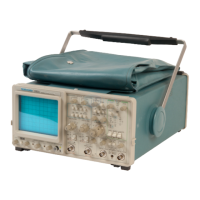
Do you have a question about the Tektronix 2465 and is the answer not in the manual?
| Bandwidth | 300 MHz |
|---|---|
| Channels | 4 |
| Vertical Sensitivity | 2 mV/div to 5 V/div |
| Maximum Input Voltage | 400 V (DC + Peak AC) |
| Display Type | CRT |
| Trigger Modes | Auto, Normal, Single Sequence |
| Input Impedance | 1 MΩ |
| Power Requirements | 48-440 Hz |
Defines manual terms, equipment markings, and warning symbols.
Ensures safe operation through proper grounding and power cord usage.
Overview of features, electrical, and environmental specifications.
Covers safety, voltage selection, and line fuse information.
Details on power cord connection and ensuring proper instrument cooling.
Describes power-up tests and how to repackage the instrument.
Location and function of controls related to power and screen display.
Description of vertical input connectors, coupling switches, and deflection controls.
Controls for sweep speed, delay, and measurement functions.
Controls and indicators for setting up trigger modes, source, coupling, and slope.
Identification of rear panel connectors and the alphanumeric readout display.
Using graticule, cursors, and delayed sweep for measurements.
Proper grounding and connecting signals via probes or cables.
Function of input coupling and using external trigger sources.
Procedures for verifying operation and setting up a baseline trace.
Covers trace rotation, astigmatism, DC balance, and probe compensation.
Verifying signal amplitude and timing accuracy using calibration signals.
Using the Delta Volts function for voltage and ratio measurements.
Measuring time intervals, frequency, and differences using Delta Time.
Measuring phase difference and using delayed sweep for waveform analysis.
Details on options like Option 11, 1R, and various power cord configurations.
Explanation of power-up tests verifying instrument and option functionality.
